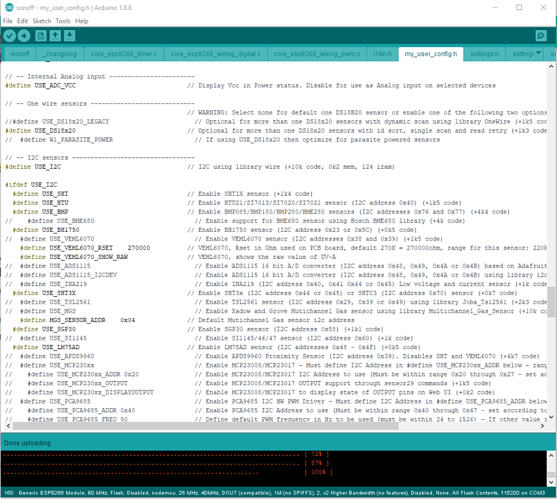How to setup and configure Arduino IDE for Tasmota compilation and upload.
this is a very good wiki written with care, so try to follow the instructions for good results
Tasmota with " Arduino IDE "
IMPORTANT: For Windows users, before executing arduino.exe add an empty folder called portable in the known folder.
Serial Monitor
after enabling Home Assistant
you need to add this line in your configuration.yaml
mqtt:
discovery: true
for auto discovery
15:32:53.216 -> 00:00:00 Project sonoff Sonoff Version 6.4.1(sonoff)-2_5_0
15:32:53.633 -> 00:00:00 WIF: Connecting to AP1 xxxxx in mode 11N as sonoff-2644...
15:32:58.133 -> 00:00:04 WIF: Connected
15:32:58.133 -> 00:00:04 DNS: Initialized
15:32:58.202 -> 00:00:04 HTP: Web server active on sonoff-2644.local with IP address 192.168.xxx.xxx
15:32:59.390 -> 15:32:58 MQT: Attempting connection...
15:32:59.538 -> 15:32:58 MQT: Connected
15:32:59.538 -> 15:32:58 MQT: sonoff/tele/LWT = Online (retained)
15:32:59.538 -> 15:32:58 MQT: sonoff/cmnd/POWER =
15:32:59.591 -> 15:32:58 MQT: sonoff/tele/INFO1 = {"Module":"Sonoff Basic","Version":"6.4.1(sonoff)","FallbackTopic":"cmnd/DVES_F12A5454_fb/","GroupTopic":"sonoffs"}
15:32:59.591 -> 15:32:58 MQT: sonoff/tele/INFO2 = {"WebServerMode":"Admin","Hostname":"sonoff-2644","IPAddress":"192.168.xxx.xxx"}
15:32:59.591 -> 15:32:58 MQT: sonoff/tele/INFO3 = {"RestartReason":"External System"}
15:32:59.591 -> 15:32:58 MQT: sonoff/stat/RESULT = {"POWER":"OFF"}
15:32:59.591 -> 15:32:58 MQT: sonoff/stat/POWER = OFF
15:32:59.591 -> 15:32:58 MQT: homeassistant/light/F12A54_LI_1/config = (retained)
15:32:59.640 -> 15:32:58 MQT: homeassistant/switch/F12A54_RL_1/config = {"name":"Sonoff","cmd_t":"~cmnd/POWER","stat_t":"~tele/STATE","val_tpl":"{{value_json.POWER}}","pl_off":"OFF","pl_on":"ON","avty_t":"~tele/LWT","pl_avail":"Online","pl_not_avail":"Offline","uniq_id":"F12A54_RL_1","device":{"identifiers":["F12A54"],"name":"Sonoff","model":"Sonoff Basic","sw_version":"6.4.1(sonoff)","manufacturer":"Tasmota"}, "~":"sonoff/"} (retained)
15:32:59.640 -> 15:32:58 MQT: homeassistant/light/F12A54_LI_2/config = (retained)
15:32:59.640 -> 15:32:58 MQT: homeassistant/switch/F12A54_RL_2/config = (retained)
15:32:59.690 -> 15:32:58 MQT: homeassistant/light/F12A54_LI_3/config = (retained)
15:32:59.690 -> 15:32:58 MQT: homeassistant/switch/F12A54_RL_3/config = (retained)
15:32:59.690 -> 15:32:58 MQT: homeassistant/light/F12A54_LI_4/config = (retained)
15:32:59.690 -> 15:32:58 MQT: homeassistant/switch/F12A54_RL_4/config = (retained)
15:32:59.690 -> 15:32:58 MQT: homeassistant/light/F12A54_LI_5/config = (retained)
15:32:59.690 -> 15:32:58 MQT: homeassistant/switch/F12A54_RL_5/config = (retained)
15:32:59.690 -> 15:32:58 MQT: homeassistant/light/F12A54_LI_6/config = (retained)
15:32:59.690 -> 15:32:58 MQT: homeassistant/switch/F12A54_RL_6/config = (retained)
15:32:59.690 -> 15:32:58 MQT: homeassistant/light/F12A54_LI_7/config = (retained)
15:32:59.690 -> 15:32:58 MQT: homeassistant/switch/F12A54_RL_7/config = (retained)
15:32:59.737 -> 15:32:58 MQT: homeassistant/light/F12A54_LI_8/config = (retained)
15:32:59.737 -> 15:32:58 MQT: homeassistant/switch/F12A54_RL_8/config = (retained)
15:33:07.674 -> 15:33:06 MQT: sonoff/tele/STATE = {"Time":"2019-02-25T15:33:06","Uptime":"0T00:00:14","Vcc":3.014,"SleepMode":"Dynamic","Sleep":50,"LoadAvg":19,"POWER":"OFF","Wifi":{"AP":1,"SSId":"xxxx","BSSId":"48:F8:B3:xx:xx:xx","Channel":10,"RSSI":68}}
15:33:33.802 -> 15:33:32 MQT: sonoff/tele/STATE = {"Time":"2019-02-25T15:33:32","Uptime":"0T00:00:40","Vcc":3.014,"SleepMode":"Dynamic","Sleep":50,"LoadAvg":19,"POWER":"ON","Wifi":{"AP":1,"SSId":"xxxx","BSSId":"48:F8:B3:xx:xx:xx","Channel":10,"RSSI":70}}
15:33:33.802 -> 15:33:32 MQT: sonoff/stat/RESULT = {"POWER":"ON"}
15:33:33.802 -> 15:33:32 MQT: sonoff/stat/POWER = ON
15:33:35.862 -> 15:33:34 MQT: sonoff/tele/STATE = {"Time":"2019-02-25T15:33:34","Uptime":"0T00:00:42","Vcc":3.015,"SleepMode":"Dynamic","Sleep":50,"LoadAvg":19,"POWER":"OFF","Wifi":{"AP":1,"SSId":"xxxx","BSSId":"48:F8:B3:xx:xx:xx","Channel":10,"RSSI":72}}
15:33:35.862 -> 15:33:34 MQT: sonoff/stat/RESULT = {"POWER":"OFF"}
15:33:35.862 -> 15:33:34 MQT: sonoff/stat/POWER = OFF
Information Menu
| Program Version | 6.4.1(sonoff) |
|---|---|
| Build Date & Time | 2019-02-25T15:26:12 |
| Core/SDK Version | 2_5_0/3.0.0-dev(c0f7b44) |
| Uptime | 0T00:56:05 |
| Flash write Count | 11 at 0xF9000 |
| Boot Count | 1 |
| Restart Reason | External System |
| Friendly Name 1 | Sonoff |
| AP1 SSId (RSSI) | xxxx (72%) |
| Hostname | sonoff-2644 |
| IP Address | 192.168.xxx.xxx |
| Gateway | 192.168.xxx.xxx |
| Subnet Mask | 255.255.255.0 |
| DNS Server | 192.168.xxx.xxx |
| MAC Address | 5C:CF:7F:F1:2A:54 |
| MQTT Host | 192.168.xxx.xxx |
| MQTT Port | 1883 |
| MQTT User | xxxx |
| MQTT Client | DVES_F12A5454 |
| MQTT Topic | sonoff |
| MQTT Group Topic | sonoffs |
| MQTT Full Topic | sonoff/cmnd/ |
| MQTT Fallback Topic | cmnd/DVES_F12A5454_fb/ |
| Emulation | None |
| mDNS Discovery | Enabled |
| mDNS Advertise | Web Server |
| ESP Chip Id | 15805012 |
| Flash Chip Id | 0x1640EF |
| Flash Size | 4096kB |
| Program Flash Size | 1024kB |
| Program Size | 548kB |
| Free Program Space | 452kB |
| Free Memory | 22kB |
